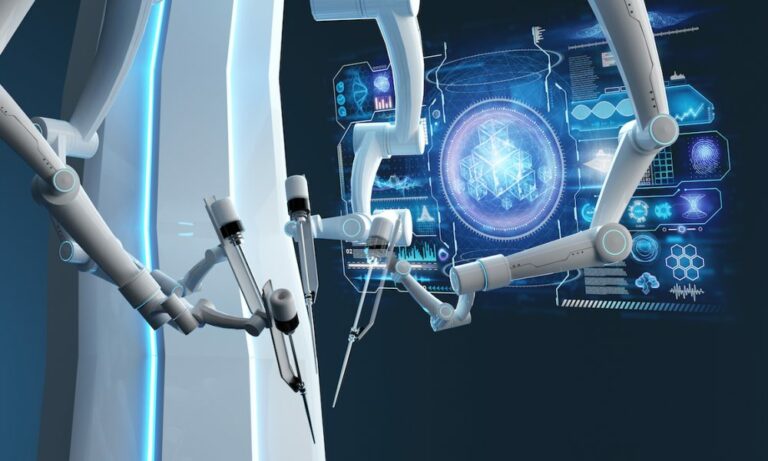Overview
As technology advances rapidly, its impact can be seen in almost every field, including healthcare. Robotic surgery has been one of the most significant innovations in healthcare technology in recent years. Robotic surgery is a surgical procedure in which mechanical arms controlled by a surgeon perform a surgical manoeuvre. It is also known as robot-assisted surgery or robotically-assisted surgery. The first robotic surgery was performed in 1985 by the PUMA 560, which was used to perform neurosurgical biopsies. Since then, robotic surgery has evolved and is used in various surgical specialities, including urology, gynaecology, cardiothoracic, and general surgery.
Advancements In Robotic Surgery
In recent years, there have been significant advancements in robotic surgery. One of the most well-known and widely used robotic surgical systems is the Da Vinci Surgical System, developed by Intuitive Surgical. It has been used in over 5 million surgeries worldwide and continues to evolve. The latest version of the system, the Da Vinci Xi, is designed to be more versatile and easier to use than previous versions.
Many other brands and products are also making significant advancements in robotic surgery. For example, Medtronic’s Mazor X Stealth Edition is a robotic surgical system that combines advanced imaging technology with robotic precision. This system can generate 3D models of the patient’s anatomy for various surgeries, including spine and brain procedures.
Many companies are making significant strides in robotic surgery. They are developing a platform using artificial intelligence and machine learning to enhance surgical outcomes. The system is designed to be more flexible and adaptable than existing robotic surgical systems.
Future of Robotic Surgery
Looking towards the future, it is expected that advancements in robotic surgery will continue to grow. Some experts predict that robotic surgery will become the standard of care for many procedures. For example, the Senhance Surgical System, developed by TransEnterix, is a new robotic surgical system designed to be more affordable and accessible to a broader range of healthcare facilities. The system uses advanced haptic feedback technology, allowing surgeons to “feel” what they do during a procedure.
Overall, the advancements in robotic surgery offer great potential for improving patient outcomes and enhancing the capabilities of surgeons. As technology improves, robotic surgery will likely become even more common and accessible.
Revolutionising Surgery: The Exciting Future of Robotic Surgery
The future of robotic surgery is promising, with numerous potential advancements on the horizon. Here are some predictions for the coming years:
-
- Increased availability and affordability: As the technology becomes more widespread, the cost of robotic surgery is likely to decrease, making it more accessible to patients around the world.
- The miniaturisation of robots: As robots become smaller and more precise, they can perform surgeries on delicate body areas with greater accuracy and minimal invasiveness.
- AI integration: Artificial intelligence will continue integrating into robotic surgical systems, allowing for more autonomous and precise procedures.
- Haptic feedback: Advances in haptic technology will allow surgeons to feel and manipulate tissues in real-time, further enhancing the precision of robotic surgery.
- Telemedicine: Remote robotic surgery, where a surgeon can perform a procedure from a different location, is a possibility that could expand access to surgical care, particularly in rural or underserved areas.
- New surgical applications: With the increasing capabilities of robotic surgery, new procedures and applications will be developed, further expanding the potential benefits of the technology.
Discovering Robotic Surgery Brands and Their Futuristic Products
There are several notable brands and products in the field of robotic surgery. Some of the most well-known include:
-
- Da Vinci Surgical System: The da Vinci Surgical System is one of the world’s most widely used robotic surgery systems. The da Vinci system is used for various procedures, including urologic, gynecologic, and general surgeries.
- Robotic-Arm Surgery: Stryker produces the Mako Robotic-Arm Assisted Surgery System, primarily used in orthopaedic surgery. The system allows for more precise and accurate implant placement during joint replacement procedures.
- Hugo RAS System: Medtronic has developed the Hugo RAS System, a modular robotic surgery system allowing greater flexibility in surgical procedures.
- Robotic Bronchoscopy: Johnson & Johnson has developed the Monarch Platform, a robotic-assisted bronchoscopy system for diagnosing and treating lung cancer.
- Verb Surgical: A joint venture between Google parent company Alphabet and Johnson & Johnson, Verb Surgical is developing a new surgical robot platform incorporating machine learning and advanced imaging technologies.
- Senhance System: TransEnterix produces the Senhance Surgical System used in laparoscopic surgeries. The system includes haptic feedback technology, which allows surgeons to “feel” the tissue they are operating on.
In the future, we can expect similar rapid innovations in robotic surgery. Advancements in machine learning, artificial intelligence, and imaging technologies will likely lead to even more precise and effective robotic surgery systems. Additionally, we may see increased use of robotic surgery in cardiovascular and neurological procedures.
What is the future of robotic surgery in healthcare?
The future of robotic surgery in healthcare is promising, with numerous potential advancements. Some predictions for the coming years include the following:
-
- Continued development of more advanced and versatile robotic surgical systems that can perform a wider range of procedures with greater precision and accuracy.
- Integrating artificial intelligence and machine learning into robotic surgery systems allows for more personalised and efficient surgical procedures.
- Advancements in virtual reality and augmented reality technologies that could enhance the surgeon’s ability to visualise and manipulate surgical sites.
- Increased adoption of robotic surgery systems in developing countries, where the technology is currently less accessible.
The future of robotic surgery is expected to bring about significant improvements in surgical outcomes, reduced recovery times, and increased patient satisfaction.

